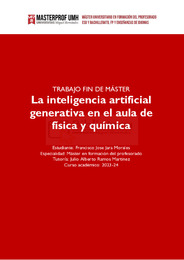Please use this identifier to cite or link to this item:
https://hdl.handle.net/11000/32995Full metadata record
| DC Field | Value | Language |
|---|---|---|
| dc.contributor.advisor | Ramos Martínez, Julio Alberto | - |
| dc.contributor.author | Jara Morales, Francisco José | - |
| dc.date.accessioned | 2024-09-06T10:03:17Z | - |
| dc.date.available | 2024-09-06T10:03:17Z | - |
| dc.date.created | 2024-06 | - |
| dc.identifier.uri | https://hdl.handle.net/11000/32995 | - |
| dc.description.abstract | Este estudio se propone como un puente hacia la comprensión general de las aplicaciones de la inteligencia artificial en la educación (AIEd), de manera que se pueda contextualizar una propuesta didáctica en el ámbito científico (STEM) que utiliza esta tecnología. Se ofrece una introducción a la inteligencia artificial y al aprendizaje automático (ML), con un repaso histórico que sitúa las nuevas tendencias en este campo. Se analiza la reciente y aún limitada literatura sobre AIEd, enfocándose particularmente en las aplicaciones en STEM. Con estos fundamentos, se presenta una propuesta docente como ejemplo de las posibilidades que brindan los nuevos modelos de lenguaje a gran escala (LLM) y el acceso a plataformas de computación en la nube. Además, se discuten las implicaciones prácticas y las consecuencias de implementar estas tecnologías en el aula, así como los retos presentes y futuros que enfrentan los docentes, incluyendo la adaptación de los currículos y la necesidad de formación continua. Finalmente, se reflexiona sobre el potencial impacto de la inteligencia artificial en el sector, destacando la importancia de las colaboraciones interdisciplinarias entre educadores y especialistas en inteligencia artificial | es_ES |
| dc.description.abstract | This study aims to serve as a bridge to the general understanding of applications of artificial intelligence in education (AIEd), enabling the contextualization of a didactic proposal in the scientific field (STEM) that utilizes this technology. An introduction to artificial intelligence and machine learning (ML) is provided, along with a historical overview that situates new trends in this field. The recent and still limited literature on AIEd is analyzed, with a particular focus on applications in STEM. With these foundations, a teaching proposal is presented as an example of the possibilities offered by large-scale language models (LLM) and access to cloud computing platforms. Additionally, the practical implications and consequences of implementing these technologies in the classroom are discussed, as well as the present and future challenges facing educators, including curriculum adaptation and the need for continuous training. Finally, reflection on the potential impact of artificial intelligence in the sector is provided, highlighting the importance of interdisciplinary collaborations between educators and artificial intelligence specialists | es_ES |
| dc.format | application/pdf | es_ES |
| dc.format.extent | 32 | es_ES |
| dc.language.iso | spa | es_ES |
| dc.publisher | Universidad Miguel Hernández | es_ES |
| dc.rights | info:eu-repo/semantics/openAccess | es_ES |
| dc.rights | Attribution-NonCommercial-NoDerivatives 4.0 Internacional | * |
| dc.rights.uri | http://creativecommons.org/licenses/by-nc-nd/4.0/ | * |
| dc.subject | Inteligencia artificial generativa | es_ES |
| dc.subject | Inteligencia artificial en educación | es_ES |
| dc.subject | Modelos de lenguaje a gran escala | es_ES |
| dc.subject | Automatización en la enseñanza | es_ES |
| dc.subject | ChatGPT | es_ES |
| dc.subject.other | CDU::3 - Ciencias sociales::37 - Educación. Enseñanza. Formación. Tiempo libre | es_ES |
| dc.title | La inteligencia artificial generativa en el aula de física y química | es_ES |
| dc.type | info:eu-repo/semantics/masterThesis | es_ES |

View/Open:
TFM Jara Morales, Francisco José.pdf
4,24 MB
Adobe PDF
Share:
.png)
